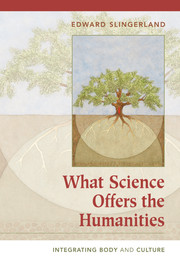Book contents
- Frontmatter
- Contents
- Figures
- Preface
- What Science Offers the Humanities
- Introduction
- PART I EXORCISING THE GHOST IN THE MACHINE
- PART II EMBODYING CULTURE
- PART III DEFENDING VERTICAL INTEGRATION
- 5 Defending the Empirical: Commonsense Realism and Pragmatic Truth
- 6 Who's Afraid of Reductionism? Confronting Darwin's Dangerous Idea
- Conclusion
- Appendix: Embodying Culture: Selected Bibliography and Other Resources
- References
- Index
6 - Who's Afraid of Reductionism? Confronting Darwin's Dangerous Idea
Published online by Cambridge University Press: 05 June 2012
- Frontmatter
- Contents
- Figures
- Preface
- What Science Offers the Humanities
- Introduction
- PART I EXORCISING THE GHOST IN THE MACHINE
- PART II EMBODYING CULTURE
- PART III DEFENDING VERTICAL INTEGRATION
- 5 Defending the Empirical: Commonsense Realism and Pragmatic Truth
- 6 Who's Afraid of Reductionism? Confronting Darwin's Dangerous Idea
- Conclusion
- Appendix: Embodying Culture: Selected Bibliography and Other Resources
- References
- Index
Summary
Perhaps you are comfortable with the idea that human beings have an empirical prejudice, and that, because of the manner in which methods of empirical inquiry have been systematically developed in the natural sciences, natural scientific claims about a given phenomenon X are generally more reliable than guesses, intuitions, ungrounded assertions, or hearsay. Now, rate your comfort level with each of the following claims:
Life on earth originated through the algorithmic process of descent with variation combined with natural selection, as described by Darwin's theory of evolution.
Eagle eyeballs are the products of evolution.
Human eyeballs are the products of evolution.
Human bodies in general are the product of evolution; many physical differences between men and women (e.g., size, upper-body strength, ability to bear children and nurse them) are thus the product of evolution.
Human perceptual systems are the product of evolution; many details of the sensory organs and the mind's ability to perceive objects and direct the body to react to them are evolved traits.
The human mind in general is the product of evolution; many mental differences (e.g., general IQ, spatial-reasoning skills, emotional empathetic abilities) between individuals are therefore the products of evolution.
As products of a blind process of replication and selection, human beings as a whole – body and mind – differ only in degree of complexity from robots or machines: we, like everything in the world, are causally determined, purely physical systems.
- Type
- Chapter
- Information
- What Science Offers the HumanitiesIntegrating Body and Culture, pp. 250 - 296Publisher: Cambridge University PressPrint publication year: 2008



